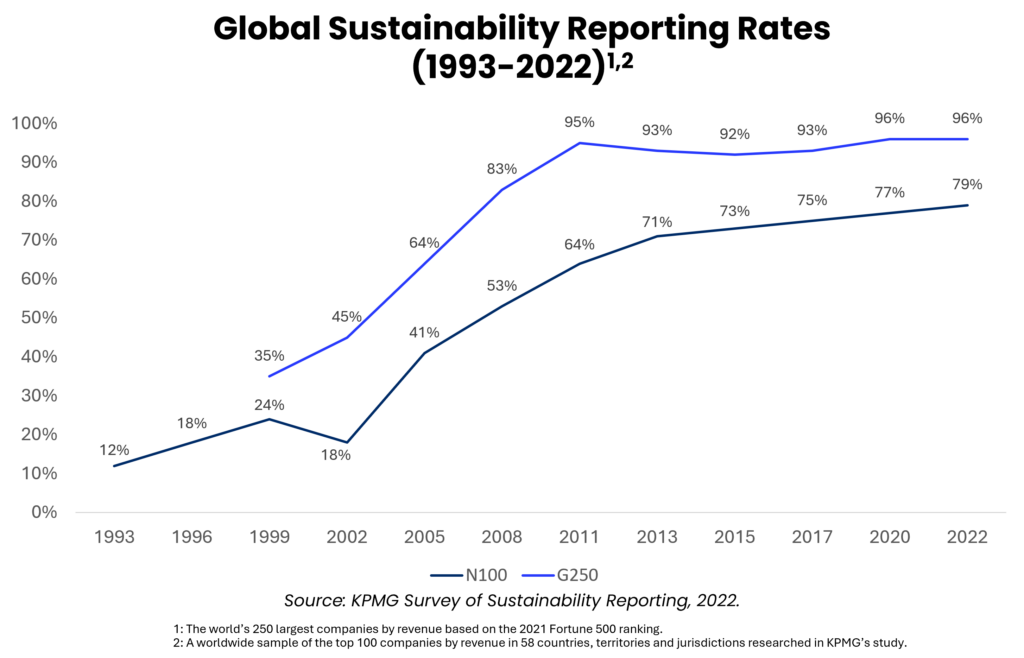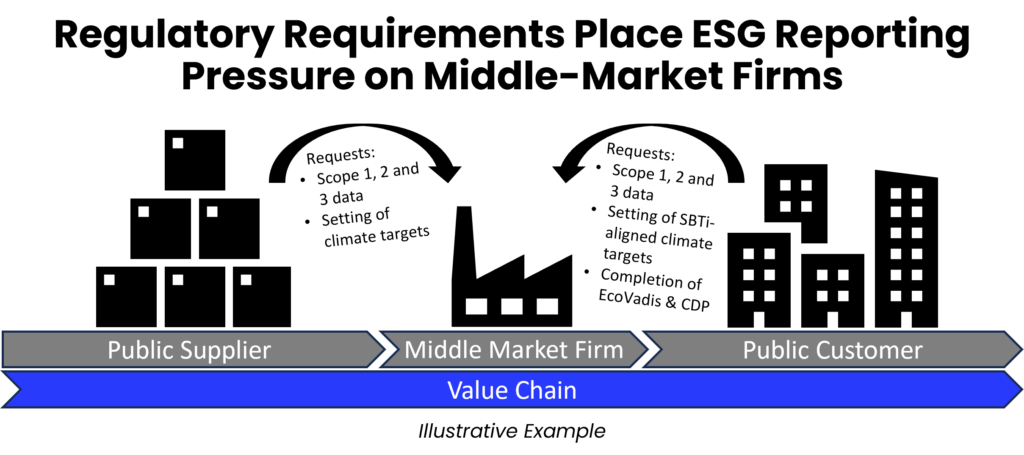Sustainability Reporting Is Working Its Way into Private Markets
As the business landscape evolves, ESG reporting is transitioning from a “nice-to-have” exercise to a core element of business strategy. This trend is illustrated by a recent EcoOnline survey, which revealed that 68% of large U.S. companies now have dedicated budgets for ESG reporting, with nearly all planning to increase spending on compliance exercises in the coming years. This trend in ESG reporting prioritization not only underscores the significance of ESG transparency for large, public enterprises, but also signals a call to action for middle-market companies, who find themselves within large public company value chains.

Regulations are Furthering Sustainability Reporting
Sustainability-linked regulations are helping drive a surge in ESG reporting, with mandates such as the EU’s Corporate Sustainability Reporting Directive (CSRD), US’ SEC climate disclosure rules, and California’s SB 253 and SB 261 leading the way. To-date, over 30 global jurisdictions have either proposed or enacted ESG disclosure regulations.
The recent increase in sustainability reporting regulations necessitates in-scope entities to report on a wide breadth of ESG topics, including scope 1, 2, & 3 emissions, material business impacts, risks and opportunities, climate transition plans, sustainable procurement activities, and TCFD-aligned disclosures, just to name a few. Most notably, scope 3 and other value chain-related disclosures expand beyond the boundary of the in-scope entity and will require the gathering and collating of ESG information from upstream suppliers and downstream customers.
The Trickle-Down Impact on the Middle Market
Large entities in scope of such regulations are recommended to begin gathering and reporting ESG data in their value chains to get ahead of regulatory pressures. The middle market, encompassing nearly 200,000 companies in the U.S. alone, generates more than $10 trillion in combined revenue annually, making up a significant portion of these value chains. As a result, we see a continued trickling down of ESG reporting on middle market companies who, while not typically in scope or thresholds for regulatory reporting requirements, are increasingly choosing to voluntarily report sustainability efforts to align with their larger customers’ strategies.
For instance, large entities are often required to report a comprehensive scope 3 emissions inventory to meet regulatory requirements. To do so, they must request scope 1, 2, and frequently scope 3 emissions data from their suppliers and partners within their value chains. As a result, these middle market companies are expected to have this information readily available. The scope of these requests extends beyond just GHG metrics; we are seeing an increasing demand for near-term, SBTi-aligned science-based targets, as well as for the completion of extensive questionnaires, such as those from CDP and EcoVadis.

Opportunities in the Private Market
In our extensive work with general partners (GPs) and their portfolio companies, we have observed that private market participants often have significant opportunities for value creation through improved governance and sustainability reporting processes. Supporting this, a 2023 study by U.S. investment manager State Street Corp. found that half of asset managers and asset owners believe private markets offer better opportunities for ESG impact than public markets, while 61% identified ESG investing being a key driver for the increased adoption of private market investments among retail investors.
The ESG Data Convergence Initiative (EDCI) is playing a crucial role in this landscape by standardizing and streamlining voluntary ESG data reporting for private market companies. Launched in 2021 by a coalition of leading global private equity firms and limited partners, the EDCI aims to establish a unified set of ESG metrics that can be consistently measured and reported across the industry. By driving this standardization, the EDCI provides a strong foundation for middle-market companies to align with evolving ESG demands, thereby supporting their larger partners and contributing to overall market sustainability.
Taking a Fit-for-Purpose Approach to ESG Information Requests
The rise in voluntary and regulatory-driven ESG information requests presents more than just a “check-the-box” exercise—it offers a strategic opportunity to create lasting value and gain a competitive advantage as a supplier and customer. To make the most of the opportunity, private, middle-market firms can focus on building materiality-driven sustainability programs while leveraging a leaner resource pool by implementing fractional resources, such as Chief Sustainability Officers. Through such fractional CSO arrangements, companies in a wide breadth of circumstances can access seasoned sustainability leaders while optimizing costs.
At FSI, we recommend taking a fit-for-purpose approach, strategically prioritizing ESG value chain information requests against the business’ own material issues with consideration of the size and influence of the value chain partner requesting the information. By strategically prioritizing key ESG disclosures, middle-market companies can not only efficiently navigate these trickle-down ESG data demands but also strengthen their market position.
Conclusion
In today’s business environment, ESG reporting is not just about meeting regulatory requirements—it’s about positioning your company for future success. At Full Scope Insights, we understand the unique challenges faced by middle-market companies, and we are here to help you navigate the complexities of ESG reporting. By adopting a fit-for-purpose approach and preparing for expanded GHG emissions reporting requirements, your company can lead with confidence, drive meaningful change, and secure a competitive edge in an increasingly demanding market.
